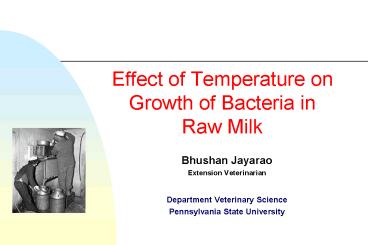Effect of Temperature on Growth of Bacteria in Raw Milk - PowerPoint PPT Presentation
1 / 20
Title:
Effect of Temperature on Growth of Bacteria in Raw Milk
Description:
Effect of Temperature on Growth of Bacteria in Raw Milk. Bhushan ... Staphylococcus aureus. Udder-2. Mastitis organisms can increase the bulk tank count ... – PowerPoint PPT presentation
Number of Views:388
Avg rating:3.0/5.0
Title: Effect of Temperature on Growth of Bacteria in Raw Milk
1
Effect of Temperature on Growth of Bacteria in
Raw Milk
- Bhushan Jayarao
- Extension Veterinarian
- Department Veterinary Science
- Pennsylvania State University
2
How do bacteria get into raw milk ?
- Udder
- Exterior of the teats and udder
- Milker
- Aerial contamination
- Milking equipment
bulk tank
3
Udder-1
- Healthy udder - 0 to lt 100 bact./ ml
- Mastitis
- Subclinical mastitis
- - lt 10,000 bacteria / ml
- Clinical mastitis
- - gt 10,000,000 bacteria / ml
- Streptococcus agalactiae
- Staphylococcus aureus
4
Udder-2
- Mastitis organisms can increase the bulk tank
count by 100,000 organisms/ ml.
- Usually observed with Streptococcal and Coliform
mastitis.
5
EXTERIOR OF UDDERS AND TEATS
- Feces/ Manure
- Soil
- Bedding
- Feed
6
EXTERIOR OF UDDER AND TEATS-2
- Between milkings cows teats may become soiled
with dung, mud, bedding materials.
- If not removed, microorganisms present in the
dirt, are washed into the milk.
7
EXTERIOR OF UDDER AND TEATS-3
- Milk from cows with unwashed teats and heavily
soiled dung may have a bacterial counts
gt 100,000 bacteria /ml
8
EXTERIOR OF UDDER AND TEATS-4
- Clipping cows around the flanks and udders
reduces amount of
contamination.
- Average bacteria/ml of raw milk
- ________________________________________________
- Farm of cows not clipped
clipped - ________________________________________________
- A 80 20,000 5,000
- B 45 48,000 10,000
- C 35 200,000 80,000
- D 20 350,000 200,000
- ________________________________________________
9
EXTERIOR OF UDDER AND TEATS-5
- Average bacteria/ml raw milk
- _______________________________________________
- Farm of cows Not washed
Washed - _______________________________________________
- A 80 20,000 6,800
- B 45 48,000 20,000
- C 35 200,000 100,000
- D 20 350,000 230,000
- _______________________________________________
- Wash the udder with warm sanitizer solution
- Iodophors commonly used
- Udder is dried with single use paper towel
10
Aerial contamination
- Least important source of bacteria in milk
- Few bacteria carried into milk by air entering
the milking machine - Cowsheds/ parlors lt 200 bacteria / L
- Few numbers of Streptococci and Gram-negative
bacteria
11
Milker
- Risk of contamination from the milker are much
less with machine milking. -
- Milkers with infectious diseases contaminating
the milk is not ruled out.
12
Water supply
- Many farms rely on untreated water supplies
- The number and types of bacteria in untreated
waters vary considerably - Organisms could originate from
- feces
- soil or vegetation
13
Water supply -2
- Fecal origin
- Coliforms
- Fecal Streptococci
- Clostridia
- Soil or vegetation
- Pseudomonas
- Coliforms
- Bacillus spores
14
Water supply -3
- Washing equipment with untreated water may not
significantly increase bacterial numbers in raw
milk.
HOWEVER - Multiplication of bacteria in residual water in
the equipment will result in more serious
contamination and problems.
ALSO - Lead to establishment and development of some
undesirable types such as gram-negative
psychrotrophic bacteria.
15
Milking equipment -1
- Growth of contaminating bacteria possible if
temperature control not maintained. -
- Milk should be cooled to lt40 F within 2 hours and
not warmed above 50 F when next milking's milk
is added.
16
Milking equipment-4
Increase in bacteria/ml in "clean" milk over a
12-h period. Storage Temp. Increase 40 F
None 50 F 5X 60 F 15X 70 F
700X 80 F 3,000X
17
Milking equipment -5
- The microflora is relatively restricted with one
particular group or two
- The groups are
- Micrococci, Streptococci, Gram-negative rods,
and asporogenous gram positive rods -
- In any one milking machine, the microflora can be
consistent or vary from time to time
18
Milking equipment -6
- Organisms that grow at refrigeration temperatures
are of concern in the bulk tank
- These organisms are mainly
- gram-negative rods e.g. Pseudomonas
- gram positive rods e.g. Bacillus
19
Putting it all together
__________________________________________________
_____ Milk Production
Storage SPC/ml
Conditions Temp. Fresh
24 hours 48 hours __________________________
_____________________________ 1. Clean cows
40 F 4,300 4,100
4,600 environment, 50 F 4,300
14,000 130,000 and utensils 60
F 4,300 1,600,000 33,000,000 2.
Clean cows, 40 F 39,000
88,000 120,000 dirty environment, 50 F
39,000 180,000 830,000 and
utensils 60 F 39,000
4,500,000 99,000,000 3. Dirty cows, 40 F
140,000 280,000 540,000
environment, 50 F 140,000
1,200,000 14,000,000 and utensils 60
F 140,000 25,000,000 640,000,000 _____________
___________________________________________
20
Why low bacterial numbers in raw milk ?
- Low bacterial numbers
- good quality cheese, yogurt, buttermilk
- longer storage life of the product
- lower risk of pathogenic organisms in milk that
grow at refrigeration temperatures such as - Yersinia entercolitica
- Listeria monocytogenes

